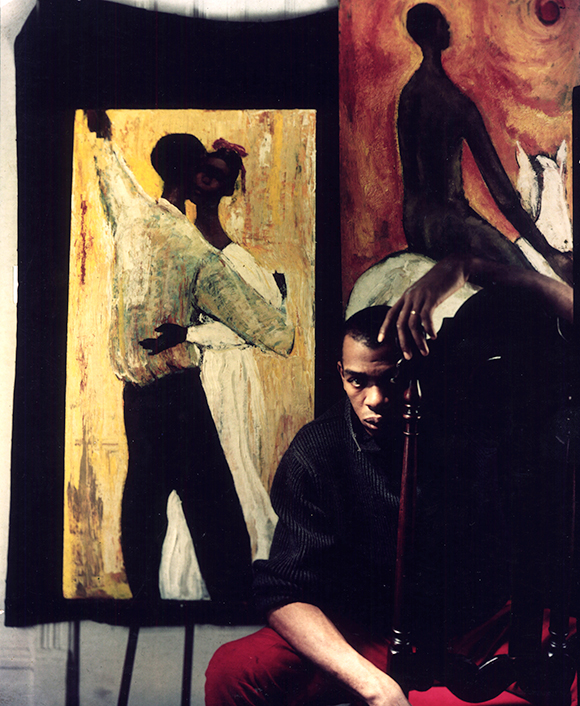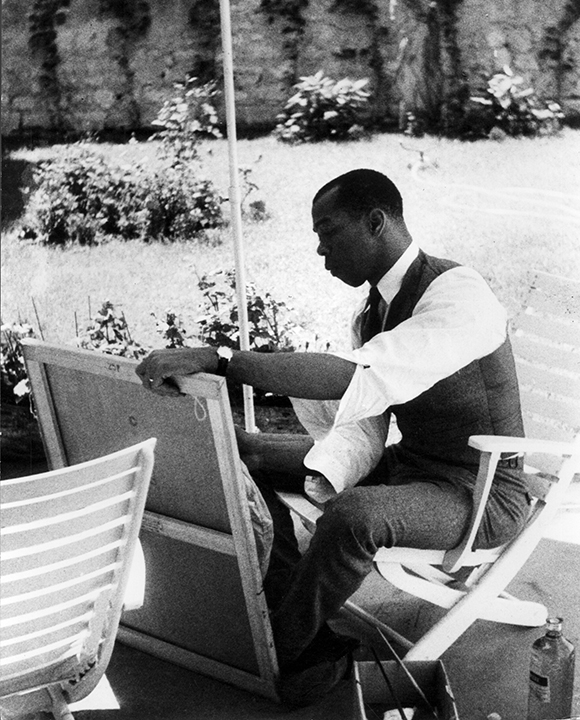Geoffrey Holder
1930 – 2014
The following is an excerpt from the catalog for the exhibition, Touched By The Muses, The Artistic World of Geoffrey Holder, curated by Reid Buckley, Mexican Cultural Institute, Washington DC, 1998.
The Artist’s Beginnings, In His Own Words
After my grand theft of my brother, Boscoe’s Windsor-Newton oil paints and the rapid succession of events that followed–my own first oil paintings, the exhibition at the Trinidad Public Library where three of my paintings were sold to Cecil Marquez, M.D. of Harlem Hospital, who chanced upon the exhibition while vacationing in Trinidad–my fifteen year old head got quite large! I vowed to have an art exhibit every year, particularly after the local newspaper, The Trinidad Guardian, called me a “Boy Wonder” and “An example for the aspiring young artists of Trinidad.”
Apart from his painting, Boscoe had his own dance company and his own radio program where he was known as the “Wizard of the Ivories”. He not only excelled as a painter and dancer, but as a pianist as well. With all that music, dance, and art, our home on Richmond Street was the eye of an artistic storm. And like Pygmalion, Boscoe shaped a lot of artists’ lives, including mine. He collected art books and left them around , which exposed me to so many different worlds; books that influenced me gave me the freedom to fantasize about unfamiliar cultures; books on Frida Kahlo and Diego Rivera and Miguel Covarrubias, for example. I remember opening up a Life magazine spread on Carmen Jones in 1943 with illustrations by Covarrubias. Thirty-two years later, when I designed costumes for the Wiz, those illustrations remained in my head because every scene was painted a different color, and I used that.
Other than Boscoe who painted black people, I was not aware of other painters who painted the golden-hue until I encountered Diego Rivera. The people of Trinidad are so racially mixed and produce the most beautiful offspring: African and Chinese, African and French, African and Indian, African and Portuguese, African and Spanish. My grandmother was Martiniquean and my grandfather, French. You could call my mother a Creole. The French enchanted with Africa has always been a wonderful melange for me. I do not know my father’s mixtures, but I know he was black and strong.


When Boscoe left for England in the 1950s, with his wife Sheila and son Christian, I inherited the dance company because, as with painting, everything Boscoe did I wanted to do. I also acquired a government job as a clerical assistant on the waterfront which enabled me to buy more canvasses for painting, more fabric for costumes and produce shows at the the Royal Victoria Institute.
During those years, many people came to Trinidad in search of Boscoe. In his absence they discovered me: people like Leonard Hanna, the Cleveland art collector; Horace Sutton, the editor of The Saturday Review of Literature; the head of the Artists’ Equity, Stuyvesant Van Veen; and painter Marion Greenwood. The shows became so successful that a friend, Donald Bain, alerted me to the plans for the first Caribbean Festival taking place in San Juan, Puerto Rico in August, 1952. I applied and my wish was granted, thanks to Donald and Lisa Lekes, a festival coordinator. But it was Catherine Randolph who was in charge of the painting activity, who encouraged me, inspired me and introduced me to pure Haitian folklore and art. She was a close friend of Raphael Tufino, one of Puerto Rico’s leading painters, and Dewitt Peters of the Centre D’Art in Haiti, and her collection of Haitian art was astonishing. The first time I saw Baron Samedi, the Haitian diety of life and death–a character I played on stage in Truman Capote’s House of Flowers, and twenty years later in the movie, Live and Let Die–was at a rehearsal of the Ballet Folklore of Haiti, danced by Celstin.
After leaving the glare and color of the Caribbean sun, arriving in New York was gray and drab. It was early Spring 1953. The new Spring leaves had not begun to dance or sing, and people wore their drab winter colors of beige, dirty brown, dull green and gray. After getting settled and learning my way around New York, I was recognized on the street by Horace Sutton. He invited me to his home for dinner to meet his wife Nancy and other friends and neighbors including Stuyvesant and Fran Van Veen who had also been to my home in Trinidad. It was an incredibly warm reception and I realized the world was very small.
Stuyvesant Van Veen invited me to his home where he held a salon with other artists. I was happy to go and to my surprise one of my paintings hung on the wall of his home. It held a proud spot next to a Max Beckmann drawing of Stuyvesant’s wife, Fran. On Sundays their home was filled with artists like Jacob Lawrence and Julio De Diego, all fascinating and brilliant people. But the conversation was not only about art. The main topic was McCarthyism for this was in the midst of the hearings. Still it was a wonderful time for me to discover other painters who I eventually had the good fortune to meet: George Tooker, Louise Nevelson, Alice Neel and Richmond Barthé. I met Richmond Barthé through Carl Van Vecten who was deeply involved in the Harlem Renaissance and knew every black artist, singer and dancer in America.
I have always painted hauntingly beautiful Creole women, and had the good fortune to marry one, Carmen de Lavallade. When I met Carmen it was as though she stepped out of one of my paintings. When I saw her face I died and was resurrected and she became even more beautiful after I met her and got to know her. She was and is elegant, ethereal, lyrical, gracious, feminine, strong, and a brilliant dancer and actress. After we married she also began painting, something she had done as a child and she sculpted, so we had much in common.
I had my first major one-man show in New York at The Barone Gallery on East 52nd Street and I planned the show to open a month after my Broadway debut in House of Flowers. I never wanted to be known as an actor/dancer who paints. Ironically, painting has always been how I earned my living.